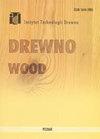Determination of fibre saturation point of selected tropical wood species using different methods
IF 0.9
4区 农林科学
Q3 MATERIALS SCIENCE, PAPER & WOOD
引用次数: 6
Abstract
The main objective of this research was to determine the fibre saturation point of tropical wood. Two different methods were used to achieve this aim: the logarithm of strength properties versus moisture content and volumetric shrinkage-moisture content plot to zero shrinkage. The test included selected wood species from Africa: Opepe, Iroko, African padouk, and Wenge, and South America: American mahogony and Ipe. For comparison, selected domestic wood species of a similar structure – European beech (Fagus sylvatica L.) – were also tested. Determination of the fibre saturation point of the selected wood species using two methods delivered similar results (the small differences were not significant). The results showed that, generally, the fibre saturation point of the tropical wood species was lower than in the case of the European wood species. The lowest values of the fibre saturation point were shown by the African padouk and Ipe (approx. 17 %). Moreover, it was found that in the case of the tropical wood, the basic density had a significant influence on the sorption properties of the tested wood species.用不同方法测定选定热带树种纤维饱和点
本研究的主要目的是确定热带木材的纤维饱和点。采用了两种不同的方法来实现这一目标:强度性能与含水率的对数和体积收缩-含水率图至零收缩。测试包括来自非洲的木材品种:奥佩、伊罗科、非洲帕多克和文格,以及南美洲的美洲红木和伊布。为了进行比较,还对结构相似的国内木材种欧洲山毛榉(Fagus sylvatica L.)进行了测试。用两种方法测定所选树种的纤维饱和点的结果相似(差异不大)。结果表明,热带树种的纤维饱和点一般低于欧洲树种。纤维饱和点的最低值是非洲的padouk和Ipe(约为1。17%)。此外,还发现在热带木材的情况下,基本密度对被试木材的吸附性能有显著影响。
本文章由计算机程序翻译,如有差异,请以英文原文为准。
求助全文
约1分钟内获得全文
求助全文
来源期刊

Drewno
MATERIALS SCIENCE, PAPER & WOOD-
CiteScore
1.10
自引率
12.50%
发文量
0
审稿时长
>12 weeks
期刊介绍:
Wood. Research papers. Reports. Announcements" ("Drewno") is an international scientific journal that publishes original results of innovatory basic and applied research concerning technological, technical, economic and ecological issues important for the wood science and forest-based industries, including their environment, and interesting to the international recipients. "Drewno" is an Open Access biannual journal.
Aims and scope:
wood science: anatomy, biology, chemistry, physics
wood mechanical and chemical technology, inter alia, sawmilling, composite wood products, wooden construction, furniture making, wood pulp, paper making
material engineering, biocomposites, nanocomposites
material management
environmental protection, safety of the processes, products and working stations
biotechnology
bioenergy, biofuels
forestry: harvesting and wood quality
wood-based industries economics
The Editorial Board of the journal especially welcomes articles concerning increase in wood resources (wood mobilisation); innovative composites and lignocellulosic materials; new trends in the protection, modification and finishing of wood; biorefining of raw wood material; "green" building; new technologies of wood waste recycling; sustainable development; innovation management; and business networks.
 求助内容:
求助内容: 应助结果提醒方式:
应助结果提醒方式:


